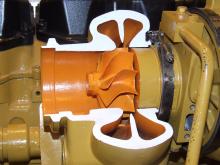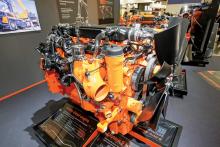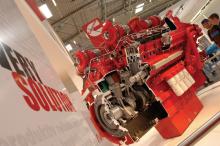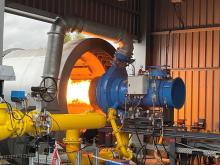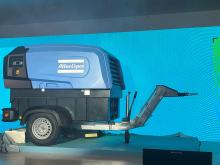Emissions remain the focus for engine development but equipment manufacturers want clarity from regulators. Emissions remain a major challenge for the off-highway construction equipment market. The EU has tough targets in this respect and its objective is an overall reduction of CO2 emissions of 80-95% by the year 2050, compared to 1990 levels. There is considerable research already underway on how to reduce fuel consumption and to help ensure the security of energy supply. A number of industry sectors, suc
Older generation machines were designed without emissions restrictions and even when in good operating condition, may be less than clean at the tailpipe
Emissions remain the focus for engine development but equipment manufacturers want clarity from regulators
However the
CECE recently took part in an event at the European Parliament debating the compatibility of EU targets for CO2 emissions in the transport sector , which included a special focus on alternative fuels and energy efficiency approaches. As a conclusion CECE was asked whether the EU should regulate the construction equipment sector on CO2 emissions or if the regulators should refrain and let the industry do this on its own.
This is of major concern. The tough regulations being imposed for controlling exhaust emissions have required massive investment by manufacturers. With the Tier 4 Final/Stage IV emissions legislation being phased in from early 2014, new construction machines in North America and Europe will become considerably cleaner at the tailpipe.
The development process to meet the requirements has been enormously expensive for the industry. And these new generation engines are also reliant on the availability of clean fuel, with extremely low levels of sulphur. The necessary clean fuel is now available in North America and Europe, but is not on sale in developing markets, which causes major problems in terms of the resale of secondhand machines. In the past, these have typically been sold on from fleets in North America and Europe into developing countries, however the non-availability of the necessary fuel is preventing this. Some manufacturers have developed technical solutions to get around this problem, although these are not available for engines or equipment from all the firms in the sector.
The emissions regulations have created major issues for the construction equipment sector and the prospect of further regulations could be in the pipeline. At the recent CECE conference in Berlin, key issues were raised regarding exhaust emissions. Dr Wolfgang Burdet is chairman of the high level technical policy advisory group for CECE. he said, “Up to 70% of available research and development capacities has to be allocated to this redesign of products and could not be used to increase customer benefits in product application or to develop new solutions for huge markets outside the EU. New engine emission legislation is by far the most expensive factor defining the costs of new machines. It also disconnects the EU and North America from growth markets such as Asia, which do not have similar legislation and where the fuel needed is not available.”
Looking ahead, the prospect of limitations on CO2 emissions could prove problematic. Systems used in the automotive sector may not be suitable or practical for use in the construction market. A key issue is that reductions in emissions for transport focus solely on the engine. But with construction applications forming part of processes, concentrating purely on the engine emissions could actually prove counter-productive.
Legislators are not fully aware of the difference between construction machines and on-highway transport. Dr Burdet said, “We fear that a ‘copy-paste’ effect of regulations known from the automotive sector may happen which would be neither appropriate for our products nor for our industry. That’s the danger. Due to our working conditions, it’s a completely different situation.”
A further problem comes in the shape of local legislation. Some urban and local authorities are keen to establish low emission zones, many of which will require the use of exhaust filtration. However, some engines will meet the Tier 4 Final/Stage IV emissions legislation without the need for exhaust filtration and these would effectively be barred from use in low emission zones as a result, even if they meet the necessary targets.
Dr Burdet said, “One important aspect is the growing pressure from local authorities, like cities, regions and even whole countries to impose requirements to retrofit diesel particulate filters to in-service machines. This is too simple a view on the problem and does not take into account its full complexity.“
He explained that this type of local legislation could even result in older machines being used for longer, increasing emissions. Meanwhile, retrofitting filters to existing equipment could result in the necessary CE certification being invalidated, making the machines not compliant from a legal perspective. And as the filters are bulky they would in most instances have to be fitted externally, resulting in restrictions to operator visibility. In some instances, this would mean machines would not be allowed to drive on the road. The effect of this would be that mobile equipment designed for use in urban environments such as small wheeled loaders or wheeled excavators or asphalt pavers would have to be delivered to site on low loaders. Regulations would also prevent them from being driven from one working area to another. And in some urban areas, they would not be allowed to operate at all.
The CO2 issue is a worrying one for the sector. Dr Burdet said, “Following up on a
The point here is that focussing on reducing CO2 emissions from the engine, is a blinkered view with regard to construction. Processes such as recycling construction materials onsite can make significantly greater reductions in CO2 overall. And there is a risk that reducing tailpipe emissions from each engine could even end up with processes that produce larger total quantities of CO2.
Dr Burdet commented that the construction sector is already highly focussed on reducing fuel consumption as the increasingly high cost of fuel makes this an economic necessity. And with reductions in fuel use, CO2 emissions are also cut. He pointed out that as the construction sector is keen to find innovative solutions that optimise the performance of the whole process, this market-driven approach will likely be more effective than additional legislation.
David Bell, chairman of the CECE high level CO2 group commented, “Clearly, our industry is already heavily pushed by customers to limit fuel consumption, which is among the most significant input costs. So I strongly recommend the EU to let us work on it without imposing regulations.”
He continued, “The European construction equipment industry is committed to CO2 reduction. It has a proven track record of increased product efficiency and consequent reduction in fuel consumption. The European mobile machinery industry is fragmented, being made up of thousands of machine types working in a wide sector of diversified applications. Many machine types are produced in relatively low volumes and any approach to CO2 reduction has to take this into account. The Industry strongly recommends a market driven approach as this will ensure innovative solutions that optimise the overall process of performance. Any programme for CO2 reduction has to include all the elements of operation - the type of equipment selected, the operation of that equipment, the efficiency of the equipment and alternative fuel sources - if we are to optimise and maximise the impact on CO2 reduction.”
For CECE, part of the challenge now is in convincing the EU legislators that the construction industry is serious about reducing CO2 emissions. Legislators often have minimal technical knowledge and may not understand the implications of rules they wish to impose, which is problematic. Simplistic approaches focussing purely on engine emissions may well be ineffective, as well as hugely expensive and could result in additional legal complexities.
The fact that EU regulators have still proven unable to establish a truly harmonised set of requirements for construction machines across Europe, highlights the inaction on the part of regulators. A study published 10 years ago on the varying technical conformity requirements of European countries showed how cost-intensive and inefficient the current regulatory process is.

